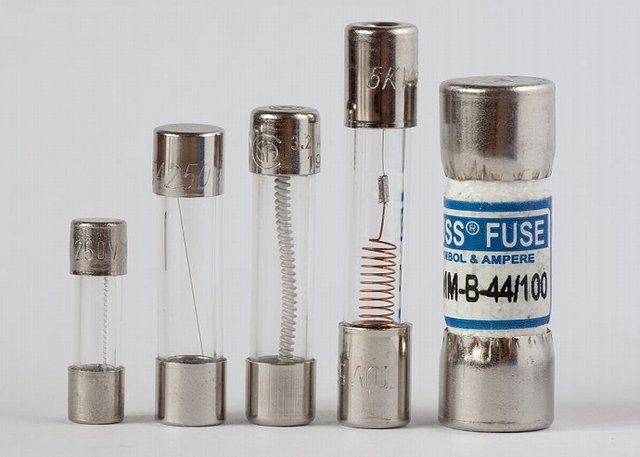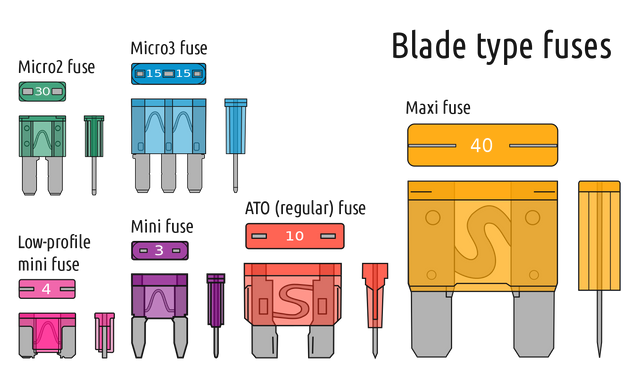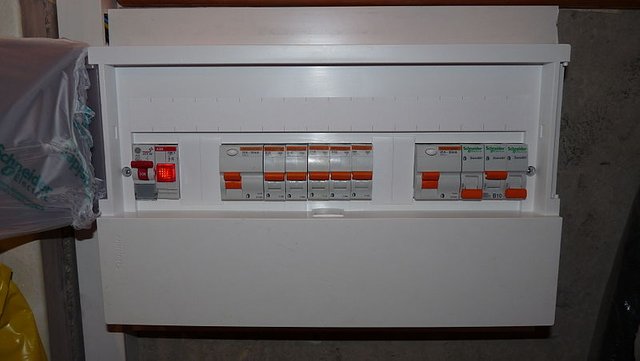Understanding The Working Principles Of Surge Protectors And Fuses (In What Way(s) Do They Defer?) — Part 2
You are welcome to this concluding part of this article that seeks to educate us on the principles underlying surge protectors and fuses. Part 1 exhaustively dealt with surge protectors and how they help safeguard home appliances during abnormal voltage transmission by swiftly diverting any excess current to ground wires via which it is safely earthed. It was also emphasized that they do not guarantee 100% protection particularly against large amount of electricity following lightning bolts. I suggest you take some minutes to read the Part 1; its so educative and a very good prerequisite to get the best of this concluding part.
[Source: Wikimedia commons. Author: Dmitry G. CC BY-SA 3.0 licensed]
Having said that, this concluding part will focus on demystifying the technology behind fuses so that even a layman will read it and easily comprehend the working mechanisms of fuses. It will also examine both protective devices to see if there's any observable difference between them. And if there is, then what is the difference? In what way do they differ? All these, among others, are what we will cover in this part 2.
Talking about fuses
Fuses are very important component of electricity transmission and domestic electricity wiring network. Without them, minor electrical faults would not only destroy appliances but could also start fires in our homes and burn them to the ground. When a fuse makes an important save, it will often blow out with a sharp CRACK sound and possibly plunge the whole house into sudden darkness. And this can be a real nuisance if it happens late in the night but the alternative is much worse. So fuses are important in homes because they protect sensitive electrical appliances by preventing currents that are bigger than they should be from being fed into the appliances and possibly damaging them. This is why we need fuses in our homes.
Explaining how fuses work to protect appliances
When electricity travels through wires, they get hot. This is the secret behind incandescent lamps where electricity passing through a very thin wire — filament — gets it so heat up that it glows and gives off light. Same also applies to an Electric toaster where electric current moving through a series of thin metal pieces cause them to generate enough heat to cook the bread in its frying pan. And this is essentially the science behind how fuses work. A typical fuse consists in a thin piece of wire designed to carry a certain amount of electricity. Any attempt to surpass this threshold will heat it up so much that it burns or melts, breaking the circuit it is fitted to and preventing normal flow of electricity. Different appliances require different amounts of electricity and so will need different fuse capacities. For example, electric toaster will require a higher fuse than an electric light.

[Source: Wikimedia commons. Author: Medvedev. CC BY-SA 3.0 licensed]
Fuses come in various types. Typically, the junction where electricity flows into a home is fitted with a type of fuse called the junction box, fusebox or the consumer unit, which functions to divide the incoming electricity into a number of separate circuits that will feed different parts of the house. A high-power circuit is meant to supply items requiring much currents like electric cookers whereas lower-rated circuits are to supply appliances not needing much currents like lights and other smaller appliances. It is also important to ensure that different parts of the house are on separate circuits so that failure in one circuit will not interrupt the normal functioning of others; and fuses fitted in every and each of these circuits to protect sensitive electrical appliances.
The fuse in older fuseboxes is just a bare piece of wire that is connected between two terminals. More recent fuseboxes have replaceable cartridge fuses in which the fuse is embedded in a glass or ceramic cylinder that you can easily snap in and out, while the latest fuseboxes do not have fuses altogether. In place of fuses, they have what's called trip switches. Any electrical faults are detected by fuseboxes after which trip switches are triggered to automatically switch off the affected circuit. Once the problem has been identified and solved, you can simply flip the switch back to get the power working again.
Deciding the right fuse for your home
The importance of using the right fuse for the right appliance cannot be overemphasized. When a small fuse is used for an appliance that draws a large current, the fuse will blow very quickly and the appliance will stop functioning. Again, when a large fuse is used for an appliance that draws a small current, it is not only that the fuse will not work, you are also at risk of being electrocuted.
There are a number of ways to replace bad fuses and you are confident it is done the right way. One way is to take out the bad one and replace it with another one of the same rating. Example, 5amp with 5amp, 13amp with 13amp,etc. Because most appliances will indicate the fuse capacity that is right for them, you can check to find out from the instruction book. You can also work by instinct bearing in mind that appliances that heat things like boilers, electric kettles, electric irons, etc will always draw high currents and so will need to be fitted with large fuses whereas appliances like table lamps, cell phone chargers, etc that do not draw much currents will only need small fuses.
Additionally, the right fuse for an appliance can also be determined by a simple calculation based on the power rating of the appliance in question and the supply voltage for that particular country.
Power, voltage and current are related to one another by the below equation:
Power (watts) = voltage (volts) × current (amp)
Note that for any appliance, fuse rating must be greater than the current the appliance draws.
So we simply divide the power rating of the appliance by voltage to find the fuse rating.
Given that you live in Nigeria where domestic voltage supply is 240v and you have an electric kettle rated at 2500 watt.
To get the current your kettle uses, just divide 2500 by 240 and you will have 10.5amp. Based on this result, you will need a 13amp fuse to use this kettle. You can use this recipe and find out the right fuse for your other appliances.
Where you are in doubt, it is advisable to always use the smallest possible fuse in which case the worst that can happen is the fuse will blow and disconnect the circuit if the current is too high. Using a fuse that's too big for an appliance will not protect the appliance from excessive currents, and worst more; you put yourself, your home, and your life at risk. It is important to bear this in mind, and that's why I highlighted it.

[Source: Wikimedia commons. Author: Havarhen. CC BY-SA 3.0 licensed]
Fuses and surge protectors compared
The fact that a fuse is designed to stop sudden large currents from getting access to sensitive appliances and damaging them makes it sound the same as a surge protector, isn't it? True as this may be, fuses actually work in a different way. Many fuses are very thin pieces of wire that are fabricated to allow only a limited amount of electricity through them. And the thicker the wire; the more current can flow through it. This means that fuses that are rated for higher currents contain thicker pieces of wire inside them.
As has been noted earlier on, fuses work by burning out where there is too much load. For instance, in a situation where too many appliances are put together in a socket, the fuse will heat up so much that it melts, disrupting the normal flow of current to protect the appliances. In some cases, fuses actually "blow"; indicating that the current passing through them is so much that they burn out immediately with a loud cracking notice. Based on this, we can say that a fuse offers a more drastic form of protection – if any goes wrong, it completely shuts off electricity supply! This is unlike a surge protector which is designed to handle smaller fluctuations in the wiring system by diverting excess current to the ground wiring network. And they don't usually shut down the circuit when a problem occurs. This is not to say one is more important than the other. We need both for maximum protection in our homes. Thanks for reading.
References for further reading
- fuses
- How fuse protection differ from surge protection
- How surge protectors work
- Surge protectors and fuses
- Surge protector
Yours truly,
@eurogee
Do You Blog About Science, Technology, Engineering, and Mathematics? If Yes, Patiently Read The Below Info


Join Euronation Community on Telegram and whatsapp through the below links to socialize with larger steemit community:

No Witnesses = No Steem Blockchain; If You Truly Love Here, Vote For Witnesses NOW!
Click This Link To Vote Now



Plagiarism.
Some of this things are not really easy for me to understand, I think because it is not my field, but the post was detailed and explanatory. Good one brother.
He made it look easy :)
and I still don't understand. Oh my head!!
I am crying sha...........
Don't worry, it can only get better :)
Really. Haha. I wrote this with very easy to grab sentences. Thanks for checking out anyways
He plagiarized.
When in doubt use a smaller rating is the holy grail of fusing. The worst that could happen is you get to replace it pretty quickly after setup as it'd fail. Better a failed fuse than a burnt out system.
Yes but not everyone think of it like that and funny enough this surges are not even that expensive but they are not exposed to it. I feel. It should come with some electric gadgets
A good surge protector is not that cheap, but when it comes to things that it protects, it's well worth the price.
Yes
Better for a surge of 3$ = roughly 1000naira to get damaged than a gadget work 200$ to get damaged
Exactly. Thanks for being here.
My highly loaded leader, thanks for checking. Respect for the load of knowledge you carry man!
Hi @eurogee!
Your post was upvoted by utopian.io in cooperation with steemstem - supporting knowledge, innovation and technological advancement on the Steem Blockchain.
Contribute to Open Source with utopian.io
Learn how to contribute on our website and join the new open source economy.
Want to chat? Join the Utopian Community on Discord https://discord.gg/h52nFrV